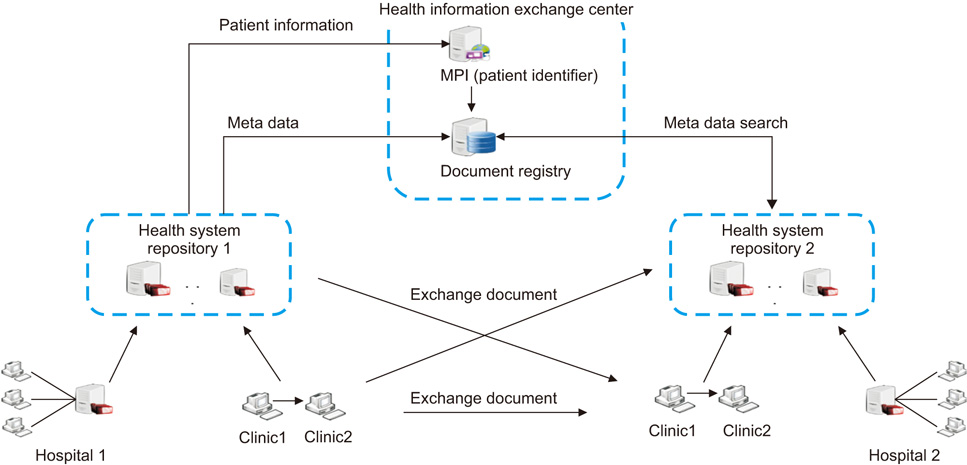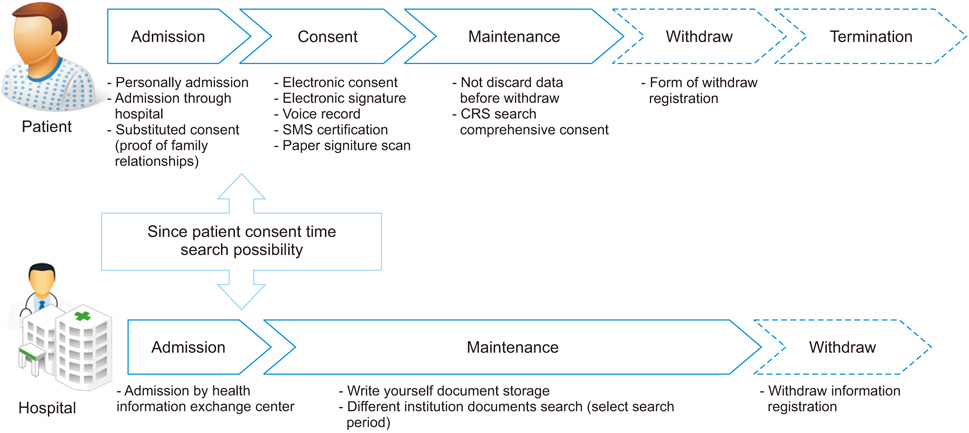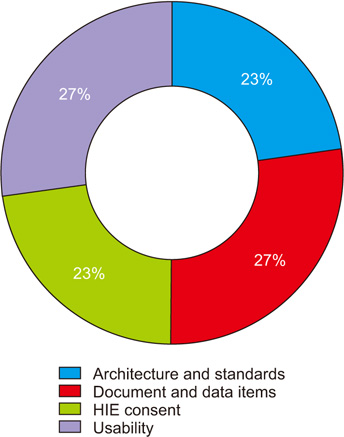Healthc Inform Res.
2017 Oct;23(4):314-321. 10.4258/hir.2017.23.4.314.
Technology and Policy Challenges in the Adoption and Operation of Health Information Exchange Systems
- Affiliations
-
- 1Office of e-Health Research and Business, Seoul National University Bundang Hospital, Seongnam, Korea.
- 2Department of Pediatrics, Seoul National University Bundang Hospital, Seongnam, Korea.
- 3Department of Otorhinolaryngology, Seoul National University Bundang Hospital, Seongnam, Korea. kimemails7@gmail.com
- KMID: 2396423
- DOI: http://doi.org/10.4258/hir.2017.23.4.314
Abstract
OBJECTIVES
This study aimed to identify problems and issues that arise with the implementation of online health information exchange (HIE) systems in a medical environment and to identify solutions to facilitate the successful operation of future HIE systems in primary care clinics and hospitals.
METHODS
In this study, the issues that arose during the establishment and operation of an HIE system in a hospital were identified so that they could be addressed to enable the successful establishment and operation of a standard-based HIE system. After the issues were identified, they were reviewed and categorized by a group of experts that included medical information system experts, doctors, medical information standard experts, and HIE researchers. Then, solutions for the identified problems were derived based on the system development, operation, and improvement carried out during this work.
RESULTS
Twenty-one issues were identified during the implementation and operation of an online HIE system. These issues were then divided into four categories: system architecture and standards, documents and data items, consent of HIE, and usability. We offer technical and policy recommendations for various stakeholders based on the experiences of operating and improving the online HIE system in the medical field.
CONCLUSIONS
The issues and solutions identified in this study regarding the implementation and operate of an online HIE system can provide valuable insight for planners to enable them to successfully design and operate such systems at a national level in the future. In addition, policy support from governments is needed.
Keyword
MeSH Terms
Figure
Cited by 3 articles
-
Design of a Hospice Referral System for Terminally Ill Cancer Patients Using a Standards-Based Health Information Exchange System
Kahyun Lim, Jeong-Whun Kim, Sooyoung Yoo, Eunyoung Heo, Hyerim Ji, Beodeul Kang
Healthc Inform Res. 2018;24(4):317-326. doi: 10.4258/hir.2018.24.4.317.Public Acceptance of a Health Information Exchange in Korea
Hayoung Park, Jong Son Park, Hye Rin Lee, Soomin Kim
Healthc Inform Res. 2018;24(4):359-370. doi: 10.4258/hir.2018.24.4.359.Association between Full Electronic Medical Record System Adoption and Drug Use: Antibiotics and Polypharmacy
Young-Taek Park, Donghwan Kim, Rae Woong Park, Koray Atalag, In Ho Kwon, Dukyong Yoon, Mona Choi
Healthc Inform Res. 2020;26(1):68-77. doi: 10.4258/hir.2020.26.1.68.
Reference
-
1. Unertl KM, Johnson KB, Gadd CS, Lorenzi NM. Bridging organizational divides in health care: An ecological view of health information exchange. JMIR Med Inform. 2013; 1(2):e3.
Article2. Shade SB, Chakravarty D, Koester KA, Steward WT, Myers JJ. Health information exchange interventions can enhance quality and continuity of HIV care. Int J Med Inform. 2012; 81(10):e1–e9.
Article3. Vest JR, Miller TR. The association between health information exchange and measures of patient satisfaction. Appl Clin Inform. 2011; 2(4):447–459.
Article4. McGee MK. Health information enhances decision making [Internet]. San Francisco (CA): Information-Week;2010. cited at 2017 Jun 16. Available from: http://www.informationweek.com/healthcare/clinicalinformation-systems/health-nformation-exchangeenhances-decision-making/d/d-id/1090004?page_number=1.5. Frisse ME, Johnson KB, Nian H, Davison CL, Gadd CS, Unertl KM, et al. The financial impact of health information exchange on emergency department care. J Am Med Inform Assoc. 2012; 19(3):328–333.
Article6. Kaelber DC, Bates DW. Health information exchange and patient safety. J Biomed Inform. 2007; 40:6 Suppl. S40–S45.
Article7. Flanders AE. Medical image and data sharing: are we there yet? Radiographics. 2009; 29(5):1247–1251.
Article8. HealthIT.gov. State health information exchange cooperative agreement program [Internet]. Washington (DC): US Department of Health and Human Services;2014. cited at 2017 Oct 1. Available from: https://www.healthit.gov/policy-researchers-implementers/state-health-information-exchange.9. Health Information and Quality Authority. Overview of healthcare interoperability standards. Dublin: Health Information and Quality Authority;2013.10. Seroussi B, Bouaud J. Adoption of a nationwide shared medical record in France: Lessons learnt after 5 years of deployment. AMIA Annu Symp Proc. 2017; 2016:1100–1109.11. Latham & Watkins Internet & Digital Media Industry Group. French digital republic law expands rights of users and regulators (Law No. 2016-321 of 7 October 2016). Los Angeles (CA): Latham & Watkins;2016.12. Bowd R. Development and evaluation of a program to improve clinician and patient communication during a telehealth consultation: CRISP Telehealth [dissertation]. Brisbane: School of Nursing;Institute of Health and Biomedical Innovation;Queensland University of Technology;2012.13. PricewaterhouseCoopers. Australia introduces mandatory data breach notification regime [Internet]. London: PricewaterhouseCoopers;2017. [cited at 2017 Oct 1. Available from: http://www.pwc.com.au/legal/assets/legaltalk/privacy-amendment-notifiable-data-breachesbill-2016.pdf.14. Lee M, Heo E, Lim H, Lee JY, Weon S, Chae H, et al. Developing a common health information exchange platform to implement a nationwide health information network in South Korea. Healthc Inform Res. 2015; 21(1):21–29.
Article15. Moghaddasi H, Rabiei R, Asadi F, Ostvan N. Evaluation of nursing information systems: Application of usability aspects in the development of systems. Healthc Inform Res. 2017; 23(2):101–108.
Article16. Korean Medical Act Paragraph 5-6 of Article 21, Law No. 14438 (Amendments Dec. 20, 2016).17. Hussain A, Rivers P, Stewart L, Munchus G. Health information exchange: current challenges and impediments to implementing national health information infrastructure. J Health Care Finance. 2015; 42(1):1–8.18. Luna D, Almerares A, Mayan JC, Gonzalez Bernaldo de Quiros F, Otero C. Health informatics in developing countries: going beyond pilot practices to sustainable implementations: a review of the current challenges. Healthc Inform Res. 2014; 20(1):3–10.
Article
- Full Text Links
- Actions
-
Cited
- CITED
-
- Close
- Share
- Similar articles
-
- Adoption of Electronic Health Records: A Roadmap for India
- Measure of Clinical Information Technology Adoption
- Factors Affecting Electronic Medical Record System Adoption in Small Korean Hospitals
- Introduction And The Current Status Of Hospital Information Systems
- Determinant factors on the adoption of application service providers in hospital information systems




